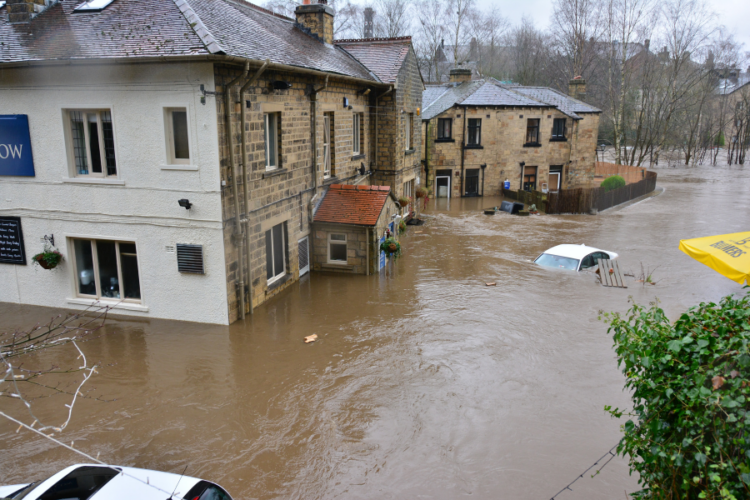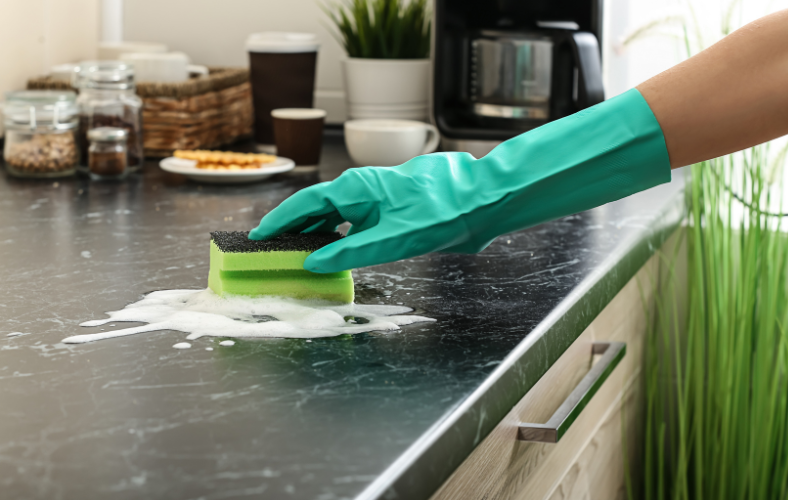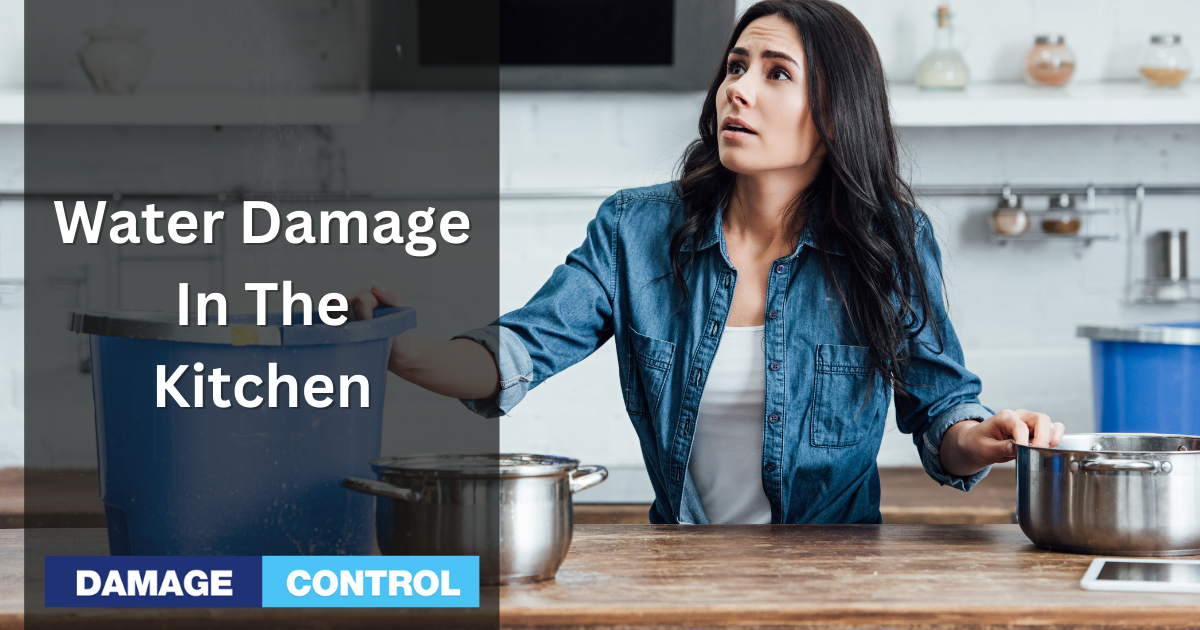Ahoy, kitchen captains! Ever battled sneaky water damage in your culinary kingdom? Trust me, it's a foe we'd all rather avoid. This dastardly villain lurks in the shadows, causing havoc if left unchecked. But fear not!
We've got you covered with a trusty guide to keep your kitchen shipshape. Why the fuss?
Timely detection and repair are crucial, folks! Ignoring this slippery scoundrel can lead to costly fixes. In this captivating read, we'll explore from A to Z of kitchen water damage—preventing it, finding it, and fixing it.
So, buckle up and join us on this watery adventure. You'll soon be a master in taming this watery beast!
Causes of Water Damage in the Kitchen
Leaky Plumbing and Burst Pipes
Oh, those pesky pipes! Leaky plumbing can wreak havoc in your kitchen. Where there is a leak, there is a chance for water to pool up.
Since mold needs moisture in order to grow and thrive, a leaky or burst pipe can supply the moisture that mold needs to grow.
Keep an eye on connections and valves to avoid soggy surprises. As for a burst pipe, insulate your pipes and watch for signs of freezing or wear to prevent a watery mess.
Faulty Appliances
Appliances gone rogue! Dishwashers, fridges, and sinks can betray you with leaks or malfunctions. Stay on top of maintenance to keep them in check.
Clogged Drains
Kitchen traffic jam! Clogged drains can lead to water overflow and damage. Not only does a clogged drain give the moisture that mold needs to survive and thrive, but it also provides the nutrients that mold needs.
Keep drains free-flowing and bid farewell to blockages.
Poor Ventilation
Moisture mayhem! Poor ventilation can cause condensation buildup, leading to water damage. Give your kitchen some breathing room with proper airflow.
One thing you can do to increase airflow is to use a fan. This is especially useful in the kitchen, where steam and condensation can build up while cooking.
Natural Disasters

Mother Nature's wrath! Floods, hurricanes, and storms can cause kitchen water damage. Be prepared and protect your culinary haven from the elements.
Human Error
Oopsie-daisy! Accidents happen, but human error can lead to water damage. Be mindful while cooking and cleaning to keep your kitchen safe and dry.
With these causes in mind, you're ready to tackle water damage in the kitchen like a pro! Knowledge is power, my friends. Let's keep those kitchens dry and fabulous!
There you have it, compadres! The top culprits behind kitchen water damage. Keep your eyes peeled and your wits about you to protect your culinary sanctuary.
Signs of Water Damage in the Kitchen
Ah, the telltale signs of water damage! Be a detective and hunt for these red flags that your kitchen might be in watery peril:
- Water Stains: Are walls, floors, and ceilings getting artsy with watercolor-like stains? Not the décor you asked for! Time to investigate.
- Musty Odors: A whiff of something funky? Musty smells can signal sneaky water damage. Follow your nose and track down the source.
- Mold and Mildew: Uninvited guests who love damp environments. Spot these pesky intruders? It's time to evict them and fix the cause.
- Warped or Buckled Flooring: Flooring doing the wave? Not a dance party, folks! Warping or buckling can hint at hidden water damage beneath.
- Discoloration or Peeling: Paint or wallpaper looking shabby? Discoloration or peeling might indicate that water's been playing mischief behind the scenes.
- Dripping or Leaking Water: The most obvious sign, but worth mentioning! Don't ignore mysterious drips – they might lead to bigger troubles.
- High Humidity Levels: Sticky and muggy, yuck! High humidity can be a sign of excess moisture in your kitchen. Time to get to the bottom of it!
Prevention of Water Damage in the Kitchen
Regular Inspection and Maintenance of Plumbing and Appliances
Don't skimp on check-ups. Keep tabs on your pipes, connections, and trusty appliances. Routine maintenance can save you from future headaches in more than one way and keep your kitchen spiffy.
Proper Installation of Appliances and Fixtures
Measure twice, install once! Enlist the help of pros or follow instructions to a T. Proper installation ensures your appliances and fixtures are shipshape, reducing the risk of watery catastrophes.
Adequate Ventilation
Give your kitchen room to breathe! Install fans or vents to whisk away steam and moisture. This helps keep condensation at bay, foiling water damage's sneaky plans.
Use of Water-Resistant Materials
Be savvy with your kitchen materials! Opt for water-resistant options like sealed countertops and waterproof flooring. These superheroes can fend off water damage and keep your kitchen looking fab.
Cleaning up Spills and Leaks Immediately
Wipe up spills and fix leaks ASAP to avoid puddles turning into oceans. Swift action keeps your kitchen safe and sound.
Regular Cleaning and Sanitizing of Kitchen Surfaces

Scrub-a-dub-dub! Keeping surfaces clean and sanitized prevents the buildup of grime and moisture. Grime can be a food source for mold; as we all know, mold and kitchens are a recipe for disaster. Plus, your kitchen will sparkle like a culinary palace!
Awareness of Potential Hazards during Cooking and Cleaning
Safety first, kitchen cadets! Be mindful of potential hazards while whipping up feasts or tackling chores. A watchful eye can prevent accidents and keep water damage at bay.
There you have it! A treasure trove of tips to prevent water damage in your kitchen. Follow these guidelines, and you'll be a bona fide water damage prevention guru!
Detection of Water Damage in the Kitchen
- Visual inspection of walls, floors, and ceilings
- Use of moisture meters and sensors
- Checking for water pressure fluctuations
- Monitoring water bills
- Keeping an eye on appliance performance
Repair of Water Damage in the Kitchen
Visual Inspection of Walls, Floors, and Ceilings
Channel your inner Sherlock and scrutinize those walls, floors, and ceilings! Regular visual inspections can help you spot early signs of water damage and save the day.
Use of Moisture Meters and Sensors
Embrace the power of moisture meters and sensors, a crucial part of any beginner's guide to humidity gauges. These gadgets work like a pro in detecting underlying problems, making them essential sidekicks to keep areas like your kitchen dry and safe. Their use transforms your approach to tackling moisture, ensuring a well-protected home environment.
Checking for Water Pressure Fluctuations
Feel the pressure! Keep tabs on your water pressure. Unusual fluctuations might be the smoking gun that water damage is afoot. Time to investigate!
Monitoring Water Bills
Put on your accountant hat! A sudden spike in your water bill might indicate a sneaky leak. Watch those numbers and track down any water-wasting culprits.
Keeping an Eye on Appliance Performance
Appliance whisperer, that's you! Monitor how your dishwasher, fridge, and other appliances perform. Odd behavior could hint at underlying water damage.
With these detection techniques under your belt, you'll be a bona fide detective! Stay vigilant, and your kitchen will remain a dry and happy haven.
Insurance and Water Damage in the Kitchen
Explanation of Homeowner's Insurance Policies
Insurance 101 is coming up! Homeowner's insurance policies are like guardian angels for your humble abode. They swoop in to save the day when disaster strikes, but it's essential to understand what's covered.
Coverage for Water Damage and Related Expenses
Roll out the red carpet for insurance coverage! Many policies cover water damage and related expenses, but reading the fine print is crucial.
Don't be shy – ask your insurance agent for the nitty-gritty on water damage protection.
Filing a Claim for Water Damage
When water damage rears its ugly head, act swiftly. Document the damage, take photos, and notify your insurance company. They'll guide you through the claim process and help you get your kitchen back in tip-top shape.
With this insurance know-how, you'll be a water damage recovery whiz! Stay informed, and your kitchen will thank you for it.
DIY Water Damage Repair in the Kitchen
When It's Safe to DIY
Hey, DIY enthusiasts! While we love rolling up our sleeves, safety comes first. Tackle minor water damage repairs yourself, but call in the pros for extensive damage or mold issues. No heroics here – safety first!
Materials and Tools Needed
Assemble your DIY toolkit! For most kitchen water damage repairs, you'll need items like:
- Screwdrivers
- Wrenches
- Putty knife
- Sandpaper
- Cleaning supplies
- Replacement parts (if required)
Gather your gear and get ready for some hands-on repair action!
Step-by-Step Instructions for Repairing Common Kitchen Water Damage Issues
Let's dive into fixing those pesky water damage problems:
- Locate the source: Before you start, pinpoint the root of the problem. Leaky pipe? Faulty appliance? Know your enemy!
- Shut off the water: Don't want a watery mess? Turn off the water supply to the affected area.
- Remove damaged materials: Time to bid farewell to waterlogged materials. Remove and discard any damaged items (following safety precautions!).
- Clean and dry: Scrub affected surfaces with soapy water and rinse. Bring out the fans and dehumidifiers to dry everything thoroughly.
- Repair or replace: Fix damaged pipes or connections and replace damaged parts or appliances.
- Seal and repaint: If needed, seal any porous surfaces, then repaint or reapply wallpaper to make your kitchen shine like new.
And voilà! With these steps, you'll conquer kitchen water damage like a DIY champ. Remember, safety first, and don't hesitate to call the cavalry for more complex issues.
Hiring a Professional Water Damage Restoration Service
Benefits of Hiring a Professional
Sometimes, it's best to leave it to the pros! A professional restoration service can save the day from serious water damage. They'll wield their expertise, experience, and fancy equipment to get your kitchen back in shape.
Choosing the Right Restoration Company
Pick your water-damage knights wisely! When selecting a restoration company, consider factors like:
- Licensing and certifications
- Reviews and testimonials
- Insurance coverage
- Availability and response time
Do your homework, and choose a company to fight for your kitchen's honor.
What to Expect During the Restoration Process
Ready for some restoration magic? Here's a sneak peek of the process:
- Assessment: Pros will inspect the damage, determine the cause, and devise a plan of action.
- Water removal: They'll extract standing water and dry your kitchen using industrial-grade equipment.
- Cleaning and sanitizing: Say goodbye to germs! Pros will clean and sanitize affected areas to keep your kitchen spiffy.
- Repair and restoration: The pièce de résistance – experts will repair or replace damaged materials, returning your kitchen to its former glory.
Cost of Water Damage Restoration Services
Professional water damage restoration costs can vary based on damage extent, location, and materials needed. Get several quotes, compare, and choose the best fit for your budget.
With professional help, your kitchen will rise like a phoenix from the watery ashes. Let the pros work their magic, and your culinary haven will return soon!
Preventing Future Water Damage in the Kitchen
Learning from Past Mistakes
Live and learn, my friends! Take those watery mishaps as lessons and stay vigilant. Keep an eye on trouble spots and avoid repeating past blunders.
Regular Inspections and Maintenance
Consistency is key! Stick to routine inspections and maintenance of your kitchen's pipes, connections, and appliances. It's like giving your kitchen a regular check-up to keep it fighting fit.
Updating Plumbing and Appliances
Out with the old, in with the new! Upgrade aging plumbing and appliances to prevent future water damage woes. Invest in your kitchen's health; it'll reward you with years of water damage-free bliss.
Installing Water Leak Detection Devices
Embrace technology! Equip your kitchen with water leak detection devices for early warning signs of trouble. These nifty gadgets can be your first line of defense against watery invaders.
Being Prepared for Natural Disasters
Expect the unexpected! Brace your kitchen for natural disasters by implementing flood barriers, sealing openings, and having an emergency plan. Be ready, and your kitchen will weather any storm.
With these preventive measures, you'll be a kitchen water damage warrior! Stay proactive and keep your culinary haven safe and dry for years.
Conclusion
Well, folks, we've journeyed through the watery world of kitchen water damage! Let's take a quick trip down memory lane and recap those essential points:
- Causes, signs, and prevention techniques for water damage
- Detection methods to stay ahead of potential issues
- DIY repair vs. hiring a professional restoration service
- Insurance know-how and future-proofing your kitchen
Remember, prevention, detection, and repair are the trifecta of water damage management. Keep your kitchen in tip-top shape by implementing these strategies and staying vigilant.
Now it's time to roll up your sleeves and make your kitchen a water-damage-free zone! You've got the knowledge, so go forth and conquer, my culinary comrades!
FAQs
Is water damage in the kitchen covered by homeowner's insurance?
Most homeowners' insurance policies cover water damage in the kitchen. However, reviewing your policy and chatting with your insurance agent to know the specifics is important.
Can I fix the water damage in the kitchen myself?
You can tackle minor water damage repairs yourself. But remember, safety first! Calling the pros for extensive damage or mold issues is best. Know your limits and keep your kitchen safe.
How much does it cost to hire a professional restoration service?
Ah, the million-dollar question. Professional water damage restoration costs vary based on damage extent, location, and materials needed. Shop around, get several quotes, and find the best fit for your budget.
How long does it take to repair water damage in the kitchen?
The repair time depends on the damage severity and the restoration method. Minor repairs could take a few hours or days, while extensive damage might require weeks. Patience is a virtue, dear kitchen dwellers!
Can water damage in the kitchen cause health problems?
Water damage can lead to mold and mildew growth, which may cause allergic reactions or respiratory issues. Keep your kitchen dry and mold-free to ensure a healthy and happy cooking haven!

